Smut Clyde, helped by Tiger BB8, is set here to prove a theorem, we shall call it the Smut-Tiger Theorem. That it is namely not just medicine, life sciences, chemistry, nanotechnology, material sciences etc which are flooded with fraud, but also the high-minded, supremely detached and allegedly incorruptible field of the theoretical mathematics. Replete with fake formulas, repeatedly plagiarised, and even with fake coauthors.
There has been fraud in maths before, Twitter followers mentioned the cases of Joy Christian, or Kenji Fukaya and the Igor and Grichka Bogdanov twins. But there, you needed the review of peer experts to solve the fake riddle. In the following story, Smut Clyde exposes a string of fraudulent maths papers in his capacity as an amateur mathematician. Where expert peer reviewers failed to spot anything at all.
The authors, who happen to be from China, seem to have engaged the services of a maths paper mill (something Smut Clyde uncovered previously for biomedicine here, here and most prominently, with his colleagues Morty, Tiger BB8 and Elisabeth Bik here). And because it is not really mathematics, the calculations in it are stolen and the formulas are made up. The latter should have been picked up by peer reviewers, except it wasn’t, because also in maths, it seems nobody cares and nobody really peer reviews anything.
What apparently was needed to convince editors and reviewers, was the addition of some preferably European-university-affiliated and western-named fictional co-authors. People who do not exist, whose only purpose was to make the fake paper mill maths paper seem less Chinese, or more white, if you like.
Which tells a lot about academia. I wish they would have included Johann Gambolputty.
“Why is it that nobody remembers the name of Johann Gambolputty… de von Ausfern-schplenden-schlitter-crasscrenbon-fried-digger-dingle-dangle- dongle-dungle-burstein-von-knacker-thrasher-apple-banger-horowitz- ticolensic-grander-knotty-spelltinkle-grandlich-grumblemeyer- spelterwasser-kurstlich-himbleeisen-bahnwagen-gutenabend-bitte-ein- nurnburger-bratwustle-gernspurten-mitz-weimache-luber-hundsfut- gumberaber-shonedanker-kalbsfleisch-mittler-aucher von Hautkopft of Ulm?“
Monty Python’s Flying Circus

Begger’s test for Schrödingerean predator-prey system
By Smut Clyde
TigerBB8 invited me to help explore the rarefied domain of high-end abstract mathematics. I was happy to oblige, in the hope of demonstrating that academic malfeasance is not restricted to nanofiction and Bad Biology. Some of what follows are Tiger’s words and findings, and some are mine.
To whet appetites, here are an unexpectedly-similar pair of passages. Below at left, some uncontroversial results from Zhang & Piskarec (2015) [4]. Valery Piskarev claims an affiliation to the University of Wollongong (south of Sydney), though there is no record of him there, nor indeed of his “Faculty of Science and Technology”. In fact both authors praise the hospitality of a non-existent Department there, and it is possible that they experienced a folie-à-deux hallucination brought about by the rigors of long-haul international flights.
“This work was completed while the authors were visiting the Department of Mathematical Sciences at the University of Wollongong, and they are grateful for the kind hospitality of the Department.“
At right, in the low-profile pages of the organ of a Serbian learned society, Qiao & Deng independently rode the same train of thought two years earlier. Yulian Zhang and Lei Qiao are based in the same city, Zhengzhou (at Henan Institute of Education and Henan University of Economics and Law respectively) so it is conceivable that they know each other and that the repetition across the two papers was an act of friendly homage rather than that ugly word, “plagiarism”.

Another example? How about He & Pang (2019b) [24] and Meng (2019) [26]?
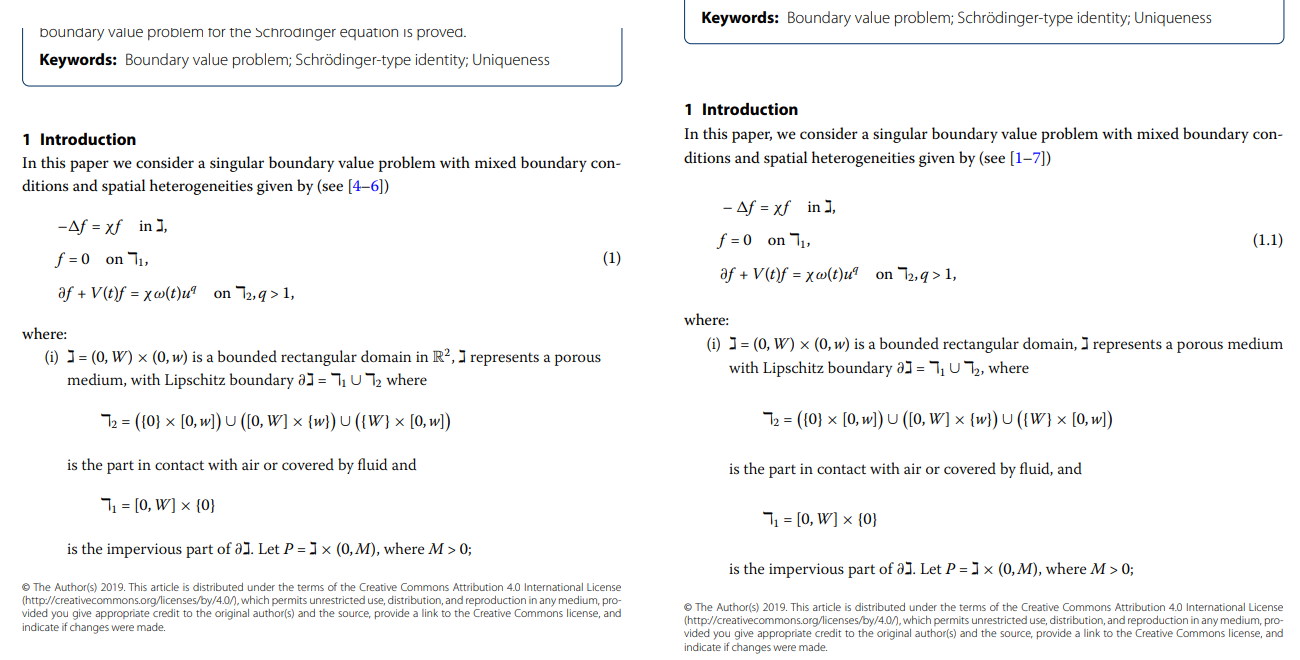
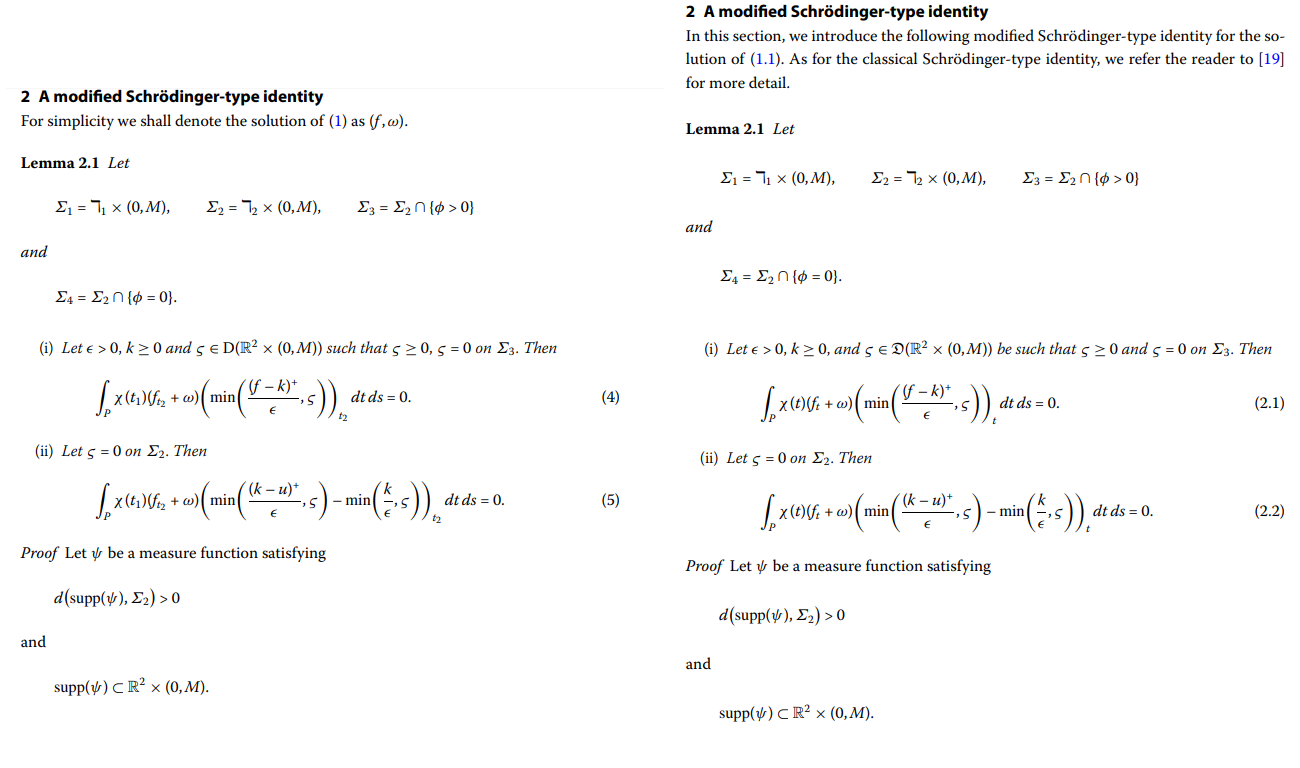

Here we find ourselves trespassing on the RetractionWatch side of the street. Credit to Adam and Ivan at RW for picking up on four retractions of head-scratching perplexity, from three Springer-Nature titles: Journal of Inequalities and Applications, Advances in Difference Equations, and Fixed Point Theory and Applications.
The four were distinguished by the presence of untraceable individuals as corresponding authors, Ikudol Miyamoto and Beatriz Ychussie, whose purported affiliations to Nagoya University and Roskilde University respectively were rejected by those institutions. Retraction also looms for a fourth J’Accuse Ychussie paper [pers.comm], published in that same Serbian mathematical journal [1] rather in the Springer trio.
Now the academic world is admirably non-judgmental on details of ontological status (Gogol would feel at home there), and fictive irreality is seldom an impediment to acquiring a CV. The main reasons for those retractions centered on the plagiarism, and the duplicate submissions elsewhere with different authorship.
In fact these cases are just the tip of the rabbit-hole, the entrance to the iceberg. Inquiry reveals a recent squall of other retractions from the same Springer journals, displaying an almost Dickensian nominative creativity, not all of them lodged in the RW Database.
It is as if exotic co-authors were being invented, to signal the international reputation and far-flung collaborative capacity of the more reality-based authors.
2 x Tanriver Ülker (Universidad Austral, Argentina); Mohamed Vetro (University of Ioannina, Greece) [5]; Costanza T. Viouonu (Hasselt University, Belgium); 2 x Alexander Yamada Jr (Stockholm University); Nanjundan Yamini (University of West Bohemia, Plzen, Czechia) [12]; 3 x Beatriz Ychussie (Roskilde University, Denmark); Eve Yuzbasi (Istanbul University) [2]; Ahmed Zama (University of Mosul) [10].
This Retraction-Note genre is dominated by a small repertoire of rationales: suborned peer-review, uncertainty of true authorship, plagiarism of previous publications, overlap with manuscripts submitted concurrently elsewhere under different authorship. It is not an Olympic-class leap of logic when we conclude that these are papermill products, sold to more than one customer, relying on moles in the peer-review system to ensure acceptance. In other words, there are people who are willing to pay to have maths papers published with their names at the top. Incapable of Mathing themselves, they need someone else to make an impressive arrangement of integrals and variations and functionals and operators on the page, like astrology signs and Kaballistic glyphs embroidered on a magician’s robe to signify that he’s a magician… actual meaning in the arrangement is optional.

Clearly the House of Springer suspect that shenanigans are widespread (though they are not forthcoming about the details of those suspicions), and kudos to them for admitting (amid shock) that gambling is going on in their establishment, and taking steps to clean up their stable. Less kudos, though, for retracting only one of each pair or triad of duplicated publications.
Anyway, we are here to help with their Augean task, with a spreadsheet of (so far) 50-plus entries. Checking those unscathed duplicates helped.
The nominally-inventive dramatis personae swells to feature 2 x Corchado Peixoto-de-Büyükkurt at the University of Delaware; Valery Piskarev [4]; Ben Rodrigo (Universidad de Talca, Chile) [19]; Hugo Roncalver (Technische Universität Berlin, Germany) [15]; Francisco Marco Usó (University of Nigeria, Nsukka) [13]; Robert Vargas-De-Teón (UNAM, México); John Vieira (Universidade Federal de Minas Gerais, Brazil); Muhammad Aslam Zaprawa (Alexandria University, Egypt); Maria Hampshire Zylbersztejn (Universidade Federal do Rio de Janeiro) [11]. If it were not for the over-representation of the end of the alphabet, the rollcall could easily be a Third Policeman homage.
We are advised [pers. comm] that the Technische Universität have no record of a Hugo Roncalver as visiting professor (or “Goncalver” according to his totally legitimate Gmail e-address), nor even of the “Institute of Mathematical Physics” where he purportedly taught. They have asked for a retraction / correction of the paper he supposedly wrote there [15], but the due processes of scholarly correction are a very slow-grinding mill indeed.
Slightly less cosmopolitan but still internationally recognised, we meet Yadong Liao (Jagiellonian University, Poland); Jing Liu (“Osaka Kyoyobu University”); Hong Wang (Universiti Kebangsaan Malaysia); and Jiani Mu and Jing Zhang, both of Faculty of Science and Technology, Tapee College, Thailand, where they really need to screen their fictitious affiliates better (one retracted and one not).
For the majority of entries in our spreadsheet (some of them retracted), the authors are confined to mainland China, having declined to pay the papermill a premium fee to receive the imprimatur of an imaginary main author overseas. Some of the actual co-authors seem to have paid to have their careers adorned with imaginary visiting appointments. Did Zongjing Jiang really enjoy the “kind hospitality of Universidad de Granada, where portions of this paper were written“? One Wei Li’s claim to have attended Norwegian University of Science and Technology, denied by that institution, may have been inspired by a different Wei Li.
Now our hypothetical papermill operators are loath to see their ingenuity go unrecognised, and they include citations to these engagingly-named co-authors in the more recent papers they sell to new customers, and those papers accrue bogus citations in turn, and it all helps one to trace the trail of forgeries, using citation services.
Self-contained, self-citing networks of mathematical fiddle-faddle are nothing new. In the most celebrated case, one Mohamed El Naschie founded the journal Chaos, Fractals & Solitons, then remained Editor-in-Chief when ownership passed to Elsevier, allowing him to foist paper after paper of pure bafflegab upon an uncomprehending world. He employed his own notation, his own unique rules for ratiocination, and a small army of sockpuppet pseudonyms to defend his theories. From Wikipedia:
“Mathematical physicist professor John C. Baez of the University of California, Riverside has called El Naschie’s work “undisciplined numerology filled with impressive buzzwords” [..]
El Naschie has said “Senior people are above this childish, vain practice of peer review.“
El Naschie’s largest contributions to science were perhaps to help discredit Elsevier publishing ethics, and the use of Impact-Factor citations-index metrics for rating journals and institutions. Archived copies are still available for much of the no-longer-extant “El Naschie Watch” blog.
Returning to our hypothesis of a papermill, fictional-character creation stopped after April 2018, and the focus broadens from the presence of spectral co-authors. Many papers fell into our list through virtue of extensive copy-pasting – the material coming sometimes from earlier entries in the list, and sometimes from an outside and presumably unwilling donor. Is it time for another example?
Liu (2019) [25], here at right, was assembled using mathematical masonry taken from Zaouche (2018) at left:
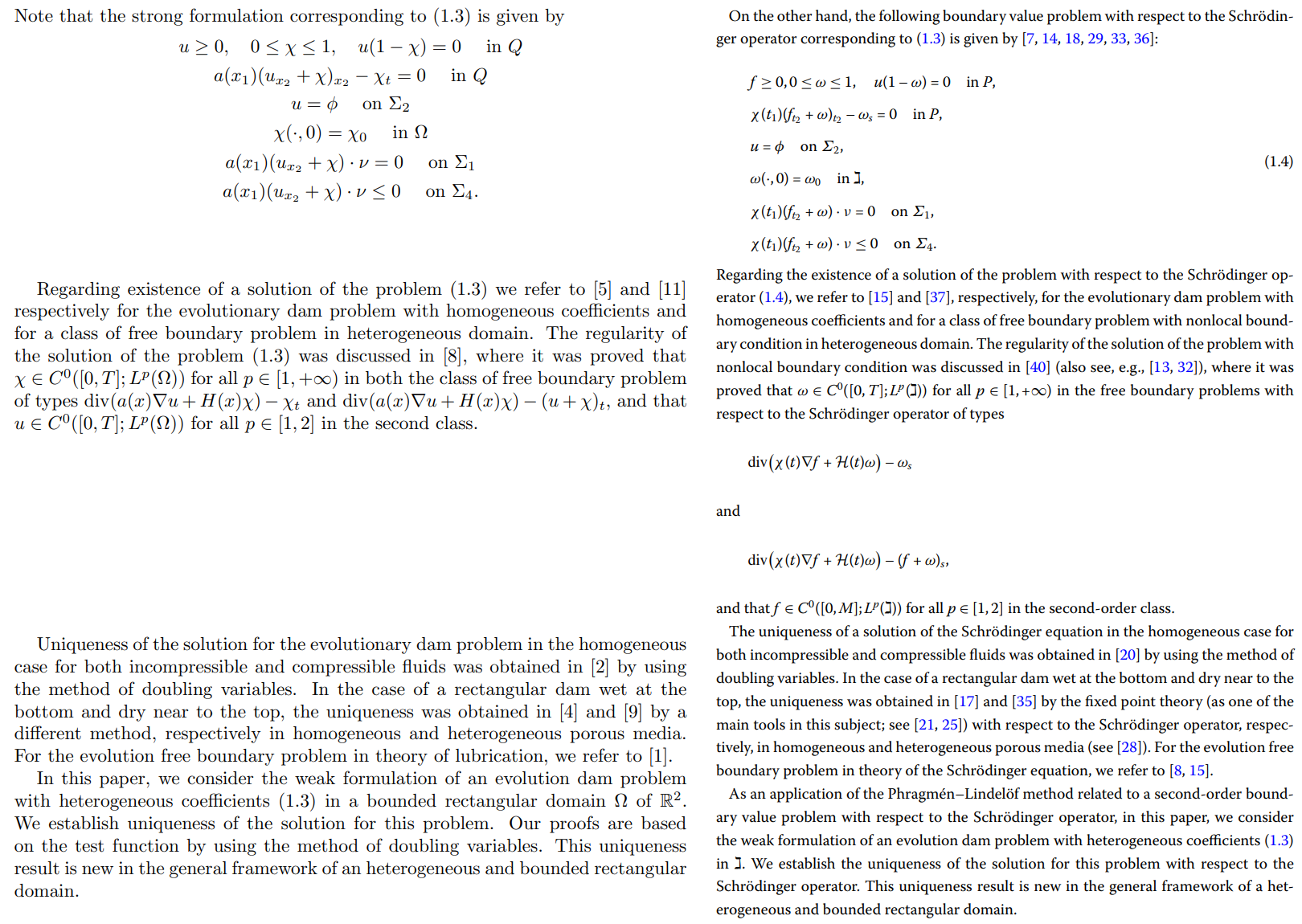
Showing admirable economy, part of that excerpt from Zaouche (2018) reappeared in Ren, Yang & Li (2020) [27]:
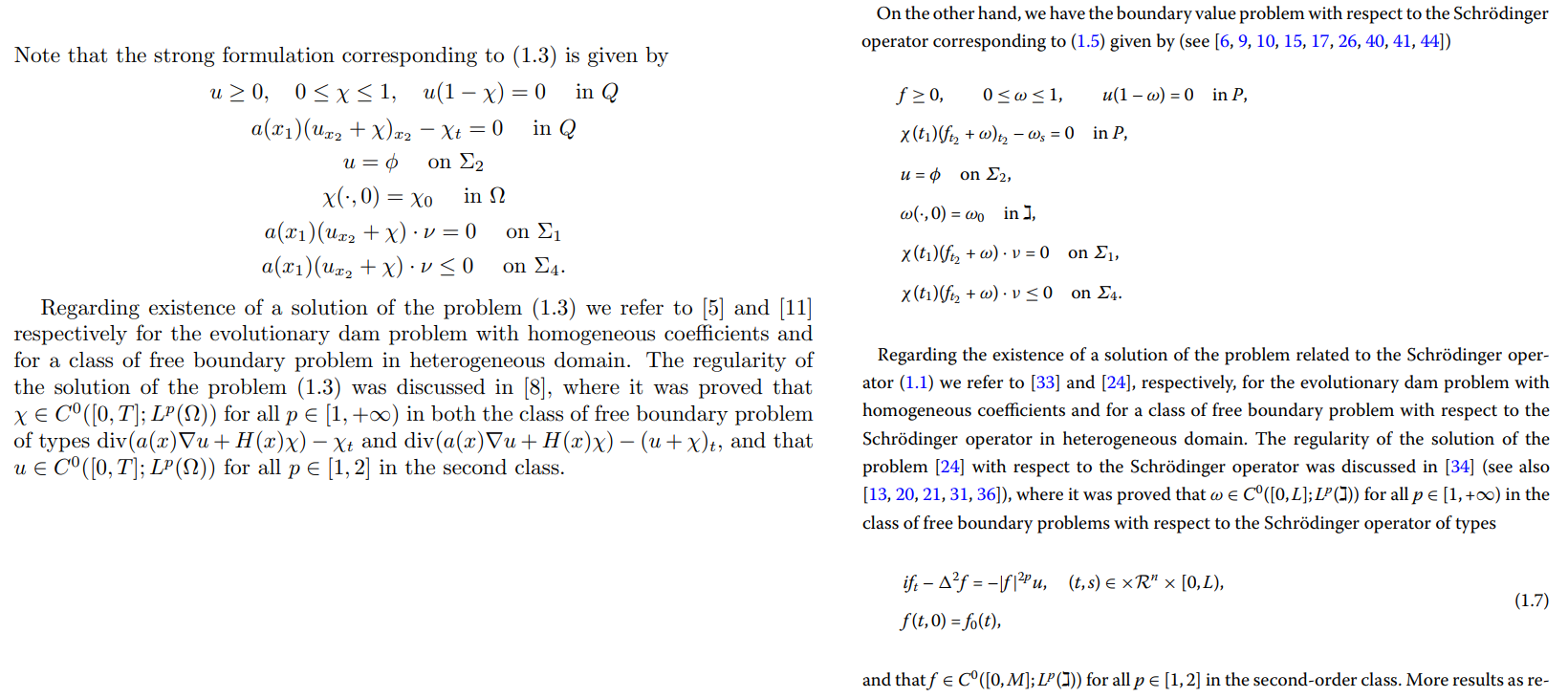
Which is not to say that passages are recycled unchanged! One hallmark of this literature is the insertion of the name of Schrödinger (or “Schrödinger type”), not to invoke any of Erwin S.’s specific contributions to physics and mathematics, but more in the way of a talismanic Word of Power, transforming a purloined passage and asserting ownership of it.
Products of this transformation include the concepts of “Schrödingerean predator-prey system”, and “the Schrödinger-prey operator”… a recognition, perhaps, that Schrödinger’s Cat does not exist in isolation (or nonexist), but is part of a broader probability-distribution ecosystem. So special commendation goes to “Existence of weak solutions for two point boundary value problems of Schrödingerean predator-prey system and their applications” (Lü & Ülker 2017) [17], and “New results on the existences of solutions of the Dirichlet problem with respect to the Schrödinger-prey operator and their applications” (Chen & Zhang 2017) [18], for they display the mathematical cargo-cult in its most egregious form. The former was retracted, the latter not, although both are patently plagiarised from Zhang et al (2015).
It is also instructive to compare sections of either paper with passages from Hu, Teng & Zhang (2014), shown above on the right.
The Schrödinger Operator is familiar to physicists, but there exists a verbal equivalent whereby affixing the abbreviated form “-Sch” to any other eponymous boundary condition or procedure for solving differential equations elevates it to an entire new level, infusing it with Sch-ness. The Sch-tic enriches this literature with Dirichlet-Sch and Poisson-Sch and Green-Sch and Riesz-Sch. Better-defined versions of these innovations do exist outside this Hortus Conclusus of Alternative Mathematics.
For many of us, the introduction to the ecological / economic niche of “papermills” was the paradigmatic example of the meta-analysis specialists. In that instance, one of the personnel turning the crank on the production line didn’t have a grasp of the statistical underpinnings, and somehow they mashed “Begg’s test” together with “Egger’s test” into a single portmanteau Begger’s test, then copied the blunder into each subsequent use of the template. This had the happy corollary that the Forces of Rectitude and Retraction could simply search the journals’ archives for a Begger’s Funnel Plot, secure in the knowledge that any study-shaped phenomenon containing such an artefact was an exercise of creativity that had never felt the surly bonds of primary data sources. Feel free to joke about how this beggars belief.
A similar diagnostic hallmark exists in the present corpus of work. May and Oster (1976) wrote a foundational document in the annals of fractal attractors and Hopf-bifurcation critical points and chaotic non-linear dynamics, and if you weren’t there in the 1980s when that whole field bifurcated spilled over into broader popular culture in a ferment of intellectual excitement then you kids should get off my grass. The point is that a genuine researcher is unlikely to misspell their names. So when a whole series of papers make the same mistake, and similarly misrepresent May & Oster’s overview of the principles, the most parsimonious explanation is that the laborers in a scriptorium were copy-pasting one initial blunder, like medieval scribes, while they assembled slabs of text on behalf of customers who needed to burnish their Non-Linear Dynamic productivity. Specifically, a blunder originating with other authors back in 2014. This sub-genre includes the cases of [17] and [18] encountered above.

Here is another curious parallelism, between Sun (2018) at left [22] and Zhang et al (2018) at right [23].
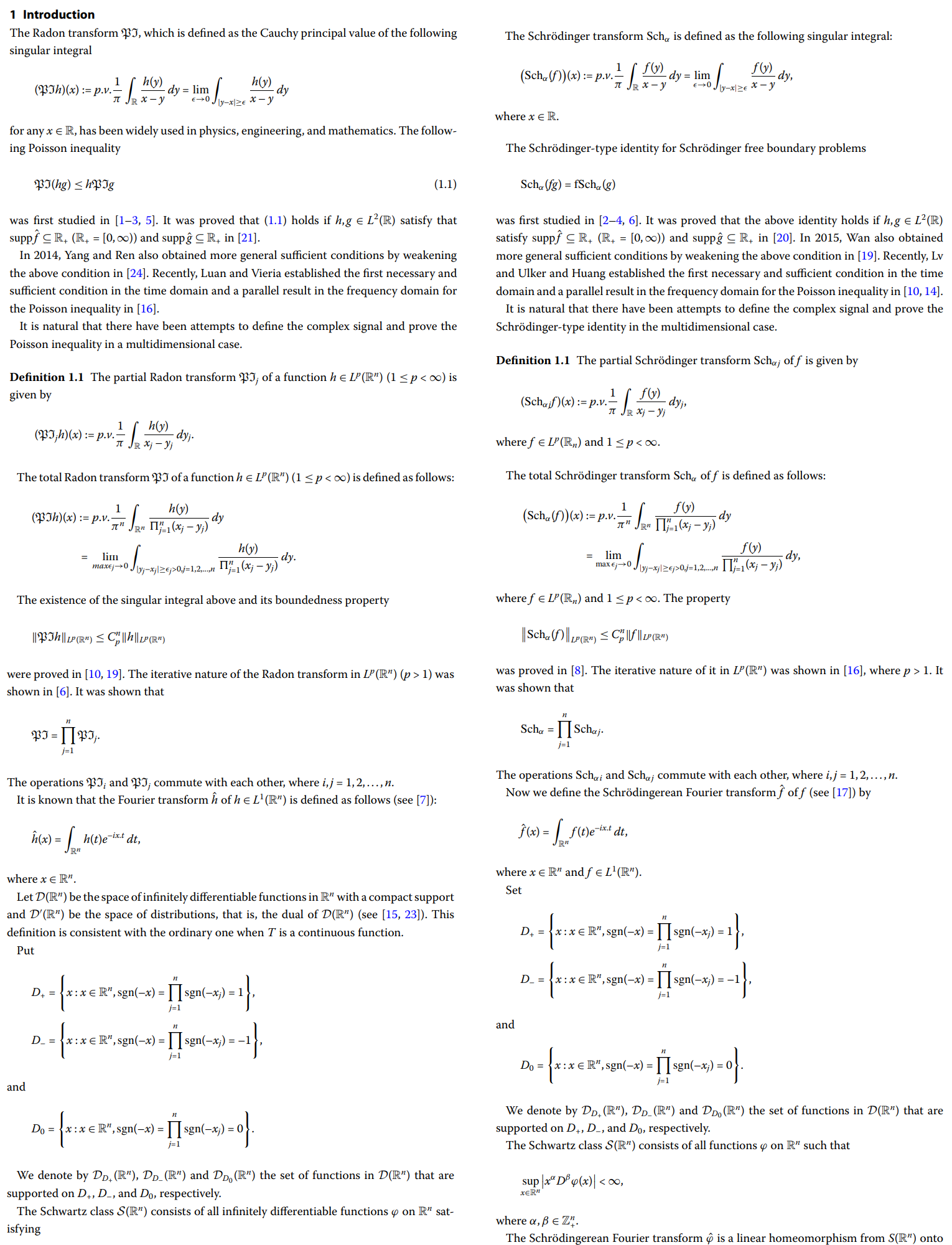
The same principal value appears to be defined as a Schrödinger transform and the Radon transform, while the “Schrodinger-type identity” takes the place of a “Poisson inequality”. Wan et al (2019) and Yang & Ren {14} respectively fill the role of “obtain[ing] more general sufficient conditions by weakening the above condition”. Then Lü & Ülker {14} and Huang {10}, or Luan & Vieria {16} respectively fill the role of “establish[ing] the first necessary and sufficient condition in the time domain and a parallel result in the frequency domain for the” Schrodinger-type identity / Poisson inequality. And so on. None of these citations match the claims made on their behalf.
There is some uncertainty whether “It was proved that the above identity holds if h, g ∈ L2(R) satisfy supp ˆf ⊆ R+ (R+ = [0,∞)) and supp gˆ ⊆ R+” by {20} or {21}, that is by Yang, D., Ren, Y.: “Dirichlet problem on the upper half space”. Proc. Indian Acad. Sci. Math. Sci. 124(2), 175–178 (2014); or Ren, Y., Yang, P.: “Growth estimates for modified Neumann integrals in a half space”. J. Inequal. Appl. 2013, 572 (2013).
The explanation might be that there are specialised roles in the papermill workshop, with different people independently compiling the main text and the References section. Thus when numbered links in the former are matched with the list of papers / chapters comprising the latter, to acknowledge a source or point to a fuller explanation, they are not in fact cogent or apposite. Conversely, we might find two overlapping Reference sections in [25] and [27] with 41 and 53 sources, ostensibly the work of unrelated authorial teams, who agree in 26 cases.
Another hallmark of the workshop is a pleasingly symmetric construction, where the Abstract and Conclusions are almost identical, differing only in a change of tense: the former is aspirational, heralding what will be proven, while the latter is triumphant, reiterating what has been proven. Any connection to the lemmas and Theorems sandwiched between the bookends is coincidental. Though for all I know, this A-B-A architecture could be standard in mathematical journals and not a hallmark after all.

So below is the diagram no-one was asking for, listing (at right) the probable papermill products identified so far. The pinkish / green / blue / orange backgrounds distinguish the three journals we started with, plus a fourth, Boundary Value Problems. Black Spots distinguish the ones that Springer have retracted so far and we charge no fee for helping them retract more. Red arcs link papers that overlap substantially, either in the Springer editors’ minds or our own. Grey arrows indicate when a paper in the corpus cites an earlier-published entry (or rather, earlier-submitted).
The same information is in the spreadsheet and in the original PubPeer threads (accessible via links in the spreadsheet) but I like pictures. Yes, it is an unholy mess, Edward Tufte’s worst nightmare, but it makes the point that there is a lot of inter-citation going on. Here’s a link to a PDF version.

Some papers are in the list not because of obvious internal shenanigans, but because they cite now-retracted papers, and are cited in turn by papers of demonstrable bogosity. We should add that this heuristic is fallible. An author might include citations to papermill products to assuage the demands of a bent peer-reviewer, and not because the bogus papers were really such an inspiration.
Down the middle, more red lines link entries to outside sources of material at left… identified sources, anyway (it is easier to find origins when they were published in free-to-read journals). Earlier we commended the economy displayed in this pilferage. Another example comes from the “Schrodingerean” cycle, where the Introduction from Zhang et al (2017) plus Sections “2 Equilibrium and local stability analysis”, “3 Existence of Hopf bifurcation” and part of “5 Numerical Simulation” became Wang & Roncalver (2017) [15] — while the Introduction again, plus Section “4 Bifurcation analysis”, became Lai, Sun & Li (2017) [16]. The abrupt bisection of the original created incoherence in the halves, not entirely compensated by the insertion of “Schrodingerean” at random intervals.
More grey arrows link to papers that cited papermill products, or were frequently cited by papermill products, for the Hortus Conclusus is still integrated into the academic world. Members of this surrounding penumbra might be perfectly cromulent contributions to the collectively-built edifice of mathematical knowledge, only receiving so much recognition from bogus papers because the papermillers are too lazy to vary their ‘References’ template… that determination would take a real mathematician to decide, for I am well out of my lane. It is sad for Yang & Ren (2014) who have been cited 11 times, that eight of those mentions came from fakes, and they have my sympathy. The same for Xu, Yang & Zhao (2013) [0], with five out of five incoming citations.
There was no room in my spaghetti diagram for the authors’ grants and funding, copied from the papers into the spreadsheet. Sometimes this is “merely corroborative detail, intended to give artistic verisimilitude to an otherwise bald and unconvincing narrative”.
In both his papers, the nonexistent Alexander Yamada Jr acknowledges support from a nonexistent Academy of Finland grant. An untraceable US NSF Grant DMS-0913205 helped with the (minimal) living costs of Beatriz Ychussie. The equally fictional Ben Rodrigo is recipient of a FONDYCET grant that does exist but was granted in this reality to Rodrigo Ponce, also of Instituto de Matemática y Física, Universidad de Talca (Prof. Ponce has a real academic email address rather than a one-use throwaway AOL account, and a CV with no trace of the “Ben Rodrigo” paper [19]).
It seems, though, that many of the actual authors in the list are supported by provincial Natural Science Foundations, or the National Natural Science Foundation, or such. How they secured that funding without the capability to write the papers expected in return, thus obliging them to call on the services of a papermill, is a question in itself.
The demands of administrative positions might be the reason why a couple of authors outsource their maths productivity. Zhiqiang Li, Yong Lu and Jianguo Sun were all Vice-Deans of various colleges (at Henan University, and Harbin Engineering University).
That brings me to another point: some authors appear in the list more than once. Curiously they sometimes use different email addresses (gmail, hotmail, etc.) for each publication, almost as if these are single-use burner e-addresses set up by the real authors for communication with the journal and then abandoned.
- Jianguo Sun has used the papermill’s services seven times! One of these contributions, Wang et al (2018) [20], is a bizarre literary cross-over mashing up abstract algebra with fuzzy-logic decision theory, giving us the novel concept of “Schrödingerean TOPSIS equations”. Here TOPSIS = “Technique for order performance by similarity to ideal solution”. I can only suppose that it was tailored to fit the CV needs of corresponding author Jong Lu, Vice-Dean of the College of Power and Energy Engineering. This may be Peak Schrödinger.
- Zhiqiang Li appears first as one of Beatriz Ychussie’s colleagues [3], then collaborating with Mohamed Vetro [5] before venturing out with a single-author paper [7]. All three subsequently received the Black Spot of Retraction.
- Those Alexander Yamada papers were shared with Tao Zhao (of Henan University of Economics and Law), who had earlier been last author of that five-times-cited paper mentioned above [0].
- Continuing with the Annals of Nonexistence: Jianjie Wang collaborated with Ahmad Zama [10], Hugo Roncalver [15], and the Malaysia-based Hong Wang [21].
- The research team of Bin Huang and Jiaofeng Wang are especially cosmopolitan, appearing first with Shi & Pu [8] but moving on to the company of the resplendent Brazil-based Maria Hampshire Zylbersztejn [11] and the Czechia-based Nanjundan Yamini [12].
- Zongcai Jiang collaborated with Corchado Peixoto-de-Büyükkurt [6], then with Francisco Marco Usó [13], before venturing out solo [14].
- Gaixian Xue appears on both sides of the Spaghetti Diagram… On the right, collaborating with Eva Yuzbasi [2] and then with the more reality-based Junfei Wang [9]. That last pair of papers are notable for their overlap with [3] and [10]. On the left side, Xue (2014) was a source of material for [3], but in compensation that paper received citations from later entries in the list. Another faculty member of Henan University of Economics and Law, Gaixian Xue may even know Tao Zhao or Zongcai Jiang or Lei Qiao.
- Getting bored now, but we find Jinjin Huang on the left-hand list as well with Huang (2017), a source of material for [17] and beneficiary of citations from later entries. Meanwhile on the right-hand list, Huang was another Ychussie colleague with [1] (the Serbian-journal paper, overlapping with [7]).
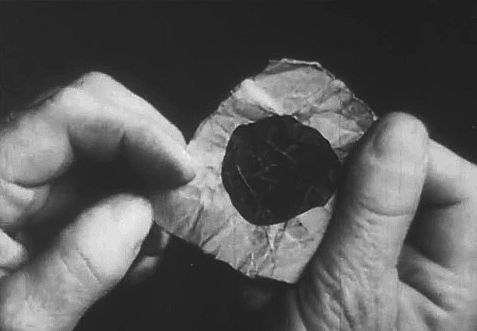
A lot of people within this academic subculture seem to be acquainted with the phenomenon of fictive co-authors. You’d think that someone among them would be able to explain what’s going on.
Many papers brought together authors who lacked any previous English-language publications but otherwise had little in common (some are not even mathematicians, though there is no reason why high-speed railway engineers shouldn’t dabble in the Higher Abstractions). It is as if they agreed to share the costs.
In total, we have 77 authors from 43 institutions, from vocational schools to top first-tier universities (not including 2 industry companies).
Earlier papers in the list (2014-2016) were marked by the presence of overseas authors for the sake of plausibility… so far overseas that they have fallen off the edge of consensus reality. As the papermill proprietors grew more confident (Dec 2016-Feb 2018), this softened to imaginary Chinese-named authors but foreign based (or with visiting scholar status), apart from Ben Rodrigo. Finally they knew that their products would be accepted without the silly-buggers.
Sources:
0. “Dirichlet problems of harmonic functions”, Gang Xu, Pai Yang, Tao Zhao (2013) Boundary Value Problems doi: 10.1186/1687-2770-2013-262
- “The modification of Poisson-Sch integral on cones and its applications”, Jinjin Huang & Beatriz Ychussie (2016) Filomat doi: 10.2298/FIL1612291H [PubPeer]
- “Fixed point theorems for solutions of the stationary Schrödinger equation on cones”, Gaixian Xue, Eve Yuzbasi (2015) Fixed Point Theory & Applications doi: 10.1186/s13663-015-0275-8 [PubPeer]
- “Sharp geometrical properties of a-rarefied sets via fixed point index for the Schrödinger operator equations”, Zhiqiang Li, Beatriz Ychussie (2015) Fixed Point Theory & Applications doi: 10.1186/s13663-015-0342-1 [PubPeer]
- “A note on the boundary behavior for a modified Green function in the upper-half space”, Yulian Zhang, Valery Piskarev (2015) Boundary Value Problems doi: 10.1186/s13661-015-0363-z [PubPeer]
- “Levin’s type boundary behaviors for functions harmonic and admitting certain lower bounds”, Zhiqiang Li, Mohamed Vetro (2015) Boundary Value Problems doi: 10.1186/s13661-015-0421-6 [PubPeer]
- “Growth property at infinity of harmonic functions”, Zongcai Jiang, Linbo Hou, Corchado Peixoto-de-Büyükkurt (2015) Journal of Inequalities & Applications doi: 10.1186/s13660-015-0919-6 [PubPeer]
- “Boundary behaviors of modified Green’s function with respect to the stationary Schrödinger operator and its applications”, Zhiqiang Li (2015) Boundary Value Problems doi: 10.1186/s13661-015-0499-x [PubPeer]
- “Boundary value behaviors for solutions of the equilibrium equations with angular velocity”, Jiaofeng Wang, Jun Pu, Bin Huang, Guojian Shi (2015) Boundary Value Problems doi: 10.1186/s13661-015-0496-0 [PubPeer]
- “An application of the inequality for modified Poisson kernel”, Gaixian Xue, Junfei Wang (2016) Journal of Inequalities & Applications doi: 10.1186/s13660-016-0959-6 [PubPeer]
- “Solutions of the Dirichlet–Schrödinger problems with continuous data admitting arbitrary growth property in the boundary”, Jianjie Wang, Jun Pu, Ahmed Zama (2016) Advances in Difference Equations doi: 10.1186/s13662-016-0751-4 [PubPeer]
- “An extension of the estimation for solutions of certain Laplace equations”, Bin Huang, Jiaofeng Wang, Maria Hampshire Zylbersztejn (2016) Journal of Inequalities & Applications doi: 10.1186/s13660-016-1109-x [PubPeer]
- “An augmented Riesz decomposition method for sharp estimates of certain boundary value problem”, Jiaofeng Wang, Bin Huang, Nanjundan Yamini (2016) Boundary Value Problems doi: 10.1186/s13661-016-0664-x [PubPeer]
- “Boundary behaviors for linear systems of subsolutions of the stationary Schrödinger equation”, Zongcai Jiang, Francisco Marco Usó (2016) Journal of Inequalities & Applications doi: 10.1186/s13660-016-1172-3 [PubPeer]
- “Some Schrödinger-type inequalities for stabilization of discrete linear systems associated with the stationary Schrödinger operator”, Zongcai Jiang (2016) Journal of Inequalities & Applications doi: 10.1186/s13660-016-1180-3 [PubPeer]
- “New applications of Schrödinger type inequalities to the existence and uniqueness of Schrödingerean equilibrium”, Jianjie Wang, Hugo Roncalver (2017) Journal of Inequalities & Applications doi: 10.1186/s13660-017-1332-0 [PubPeer]
- “Stability and direction for a class of Schrödingerean difference equations with delay”, Mingzhu Lai, Jianguo Sun, Wei Li (2017) Advances in Difference Equations doi: 10.1186/s13662-017-1132-3 [PubPeer]
- “Existences of weak solutions for two point boundary value problems of Schrödingerean predator-prey system and their applications”, Fengjiao Lü, Tanriver Ülker (2017) Advances in Difference Equations doi: 10.1186/s13662-017-1213-3 [PubPeer]
- “New results on the existences of solutions of the Dirichlet problem with respect to the Schrödinger-prey operator and their applications”, Xu Chen, Lei Zhang (2017) Journal of Inequalities & Applications doi: 10.1186/s13660-017-1417-9 [PubPeer]
- “Notes on the result of solutions of the equilibrium equations”, Gaiping He, Lihong Wang, Ben Rodrigo (2018) Boundary Value Problems doi: 10.1186/s13661-018-0959-1 [PubPeer]
- “Existence and boundary behavior of weak solutions for Schrödingerean TOPSIS equations”, Yong Wang, Jianguo Sun, Liang Kou, Yong Lu, Guodong Zhao, Wenshan Wang, Qilong Han (2018) Boundary Value Problems doi: 10.1186/s13661-018-0927-9 [PubPeer]
- “Existence and uniqueness of solutions for the Schrödinger integrable boundary value problem”, Jianjie Wang, Ali Mai, Hong Wang (2018) Boundary Value Problems doi: 10.1186/s13661-018-0993-z [PubPeer]
- “New Poisson inequality for the Radon transform of infinitely differentiable functions”, Ziyao Sun (2018) Journal of Inequalities & Applications doi: 10.1186/s13660-018-1805-9 [PubPeer]
- “Schrödinger-type identity for Schrödinger free boundary problems”, Xingjian Zhang, Duo Liu, Zining Yan, Guodong Zhao, Ye Yuan (2018) Boundary Value Problems doi: 10.1186/s13661-018-1058-z [PubPeer]
- “A modified Schrödinger-type identity: uniqueness of solutions for singular boundary value problem for the Schrödinger equation”, Hongjun He, Zhifeng Pang (2019) Boundary Value Problems doi: 10.1186/s13661-019-1261-6 [PubPeer]
- “Applications of maximum modulus method and Phragmén–Lindelöf method for second-order boundary value problems with respect to the Schrödinger operator”, Zhen Liu (2019) Boundary Value Problems doi: 10.1186/s13661-019-1267-0 [PubPeer]
- “A new application of Schrödinger-type identity to singular boundary value problem for the Schrödinger equation”, Bo Meng (2019) Boundary Value Problems doi: 10.1186/s13661-019-1279-9 [PubPeer]
- “Nonlinear conservation laws for the Schrödinger boundary value problems of second order”, Ming Ren, Shiwei Yun, Zhenping Li (2020) Boundary Value Problems doi: 10.1186/s13661-019-01311-5 [PubPeer]
- “Existence of global solutions to a quasilinear Schrödinger equation with general nonlinear optimal control conditions”, Yisheng Hu, Songhai Qin, Zhibin Liu, Yi Wang (2020) Boundary Value Problems doi: 10.1186/s13661-020-01370-z [PubPeer]

Donate!
If you are interested to support my work, you can leave here a small tip of $5. Or several of small tips, just increase the amount as you like (2x=€10; 5x=€25). Your generous patronage of my journalism will be most appreciated!
€5.00



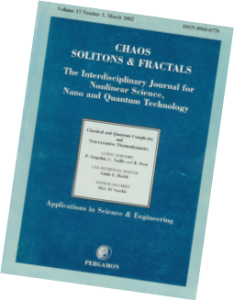

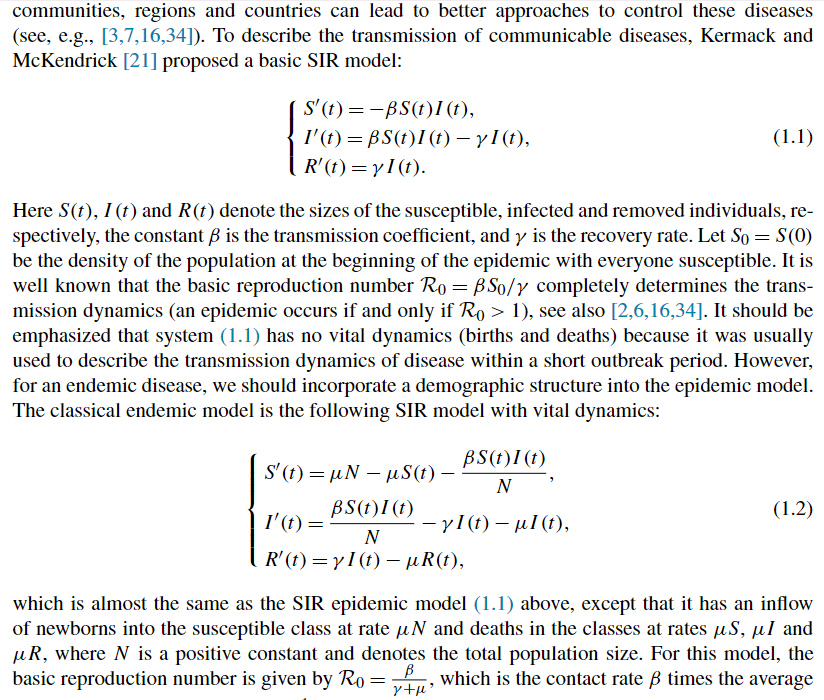
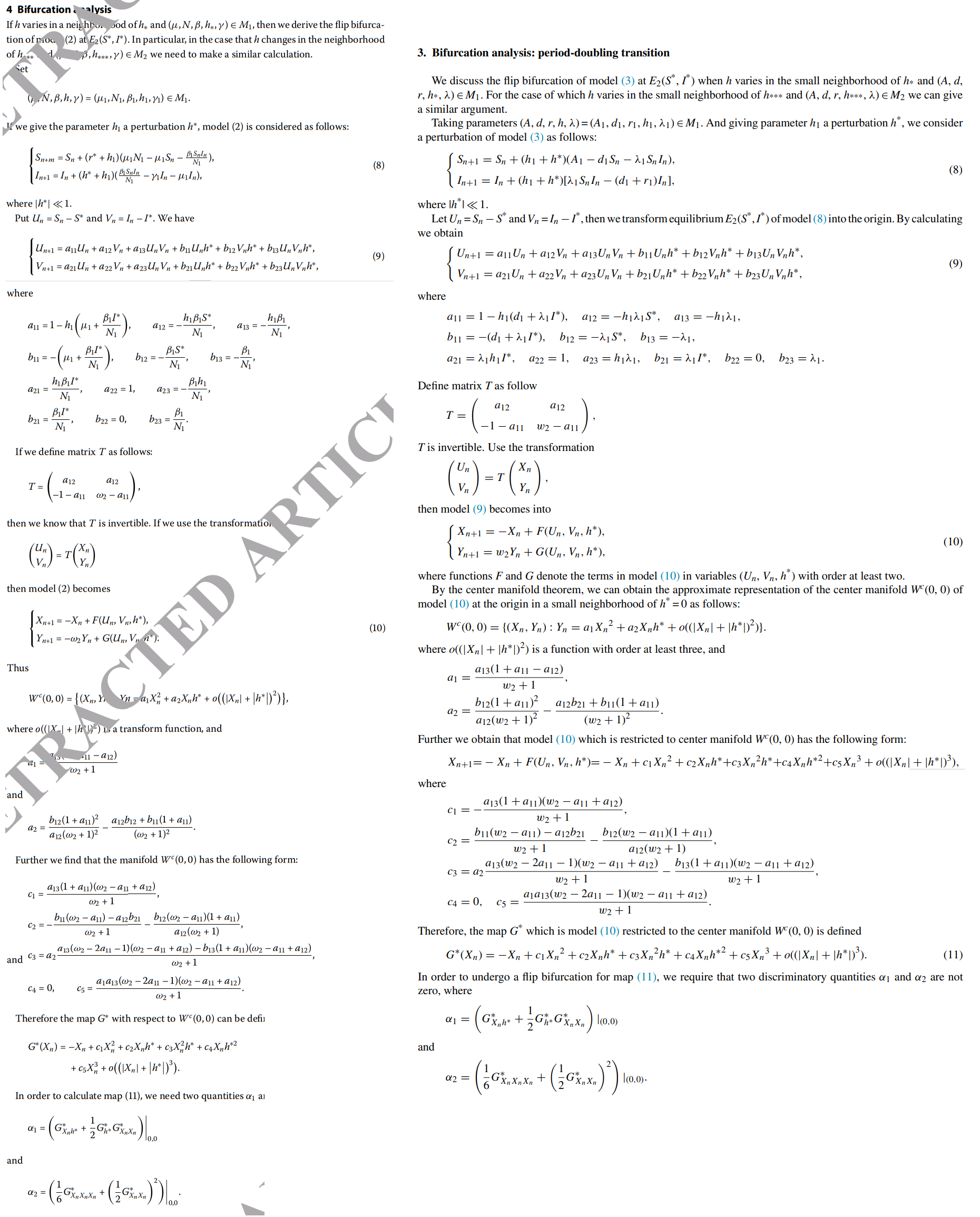

In my long experience as a reader of (and contributor to) mathematical journals of various sorts (more various as a reader than as a contributor), I have never seen a “Conclusions” section. Those relatively few of my own papers which have included such a section have been joint works (with genuine mathematical content, developed and written collaboratively) in the rather hybrid field of theoretical (but eminently applicable) robotics (where joint works about how joints work were briefly all the rage), where—especially in conference proceedings, and very especially in proceedings of IEEE conferences—the triple abominations of “Conclusions” sections, two-column format, and Procrustean upper and lower page limits, are rigorously enforced on contributors (the IEEE perhaps feeling that they must demand some rigor somewhere).
LikeLike
A real mathematician is here!! [genuflects]
LikeLike
I noted that co-authors Yamada and Ychussie claim to be supported by Academy of Finland Grant No. 176512
and NSF Grant DMS-0913205, which are as non-existent as the authors themselves, while Rodrigo receives FONDYCET grant 11130619, which does exist but is one of several elements of a stolen identity. Those do not exhaust the interesting discoveries within the Funding / Grants column of Tiger’s spreadsheet.
The work of Yang & Ren (2014) and Zhao (2014) was supported by National Natural Science Foundation of China (Grant Nos. U1304102, 11301140). A Google search for those grants finds them supporting many papers by some familiar authors:
“Rarefied sets at infinity associated with the Schrödinger operator” (Gaixian Xue 2014)
“On the Tumura-Clunie Theorem and Its Application” (Gaixian Xue and Jinjin Huang)
“MATSAEV’S TYPE THEOREMS FOR SOLUTIONS OF THE STATIONARY SCHRODINGER EQUATION AND ¨
ITS APPLICATIONS” (Lei Qiao 2016)
“Derivatives of meromorphic functions and polynomial functions” (Pai Yang & Lei Qiao 2016)
“Solutions of the Dirichlet–Sch problem and asymptotic properties of solutions for the Schrödinger equation” (Lei Qiao 2017)
“Asymptotic behaviors of Green-Sch potentials at infinity and its applications” (Lei Qiao 2017)
“Asymptotic behavior of Poisson integrals in a cylinder and its application to the representation of harmonic functions” (Lei Qiao 2018)
… and many more. Even for those authors who are not Lei Qiao, there is a link to the Maths College of Henan University of Economics and Law, so I assume that the grant is supporting a research group rather than any one individual.
LikeLike
In the small sample I have looked at so far (of papers with Lei Qiao as an author that are noted in Mathematical Reviews and published in journals I can find) there are several…shall we say “striking”?…repetitions of ordinary text easily detectable by Google. (Searching for text including strings of mathematical symbols would be a mug’s game.)
Probably just a coincidence. Law of Large Numbers and all that. Still, it might be a good pastime during one’s long hours of quarantine here at the Old Fogies Home.
LikeLike
With the Springer journals at least, the source HTML for the on-line papers is a stream of LaTeX that gets parsed and transformed into equations on the screen. So you can run a search for the LaTex. Still a mug’s game, though.
LikeLike
A lot of the material in this whole oeuvre can be traced back to a 2012 paper by Pinhong Long, Zhiqiang Gao, and Guantie Deng: “Criteria of Wiener Type for Minimally Thin Sets and Rarefied Sets Associated with the Stationary Schrodinger Operator in a Cone”… which was in turn based on Long’s 2012 PhD dissertation.
That paper has only been cited a few times (by Tao Zhao, 2014 and by Gaixian Xue, 2014), but parts of it are recognisably recycled in papers by Lei Qiao and by Qiao’s frequent co-author G.-T. Deng, either separately or together.
Now Long was building on earlier 2002 / 2007 work by Miyamoto and Yoshida. By way of Long, those authors received no end of citations from the Qiao / Deng school – should I call it the Henan school? — while the real Ikuko Miyamoto was presumably the inspiration for the fictitious “Ikudol Miyamoto” who provided Zhenhai Yan and Guojun Yan with Non-Chinese-Coauthor gravitas in a now-retracted 2015 paper.
LikeLike
Are G.-T. Deng and Guantie Deng the same?
LikeLike
Yes, G.-T. = Guantie.
LikeLike
Pingback: Brusio - Ocasapiens - Blog - Repubblica.it
Pingback: Dårligt nyt fra artikelfabrikken – hanshuttel.dk
Pingback: “We are extremely guilty and distressed” – For Better Science
Pingback: Red Flags Raised Over Chinese Research Published in Global Journals - GSRA - Global Students Recruitment Advisors
Pingback: Dead horses won’t flog themselves – For Better Science
Very nice articles, didn’t know it was also happening in Maths as well!
I just find it a bit ironic that the ads displayed during in the article point to real paper mills, actually it might have given them some more publicity to attract even customers outside China… same for the articles about Pr Raoult including ads about his book!
LikeLike
In that instance, one of the personnel turning the crank on the production line didn’t have a grasp of the statistical underpinnings, and somehow they mashed “Begg’s test” together with “Egger’s test” into a single portmanteau Begger’s test, then copied the blunder into each subsequent use of the template.
Guess if Begger’s test is a thing in 2020 despite being spotted in 2014? Oh yes, here we go:
https://scholar.google.com/scholar?as_sdt=0%2C5&as_ylo=2020&q=%22Begger%22+%22meta-analysis%22
LikeLike
So this happened: A series of Mathsmill papers were condemned by the National Natural Science Foundation, after a thorough investigation (possibly consisting of reading this post).
Decision on handling misconduct cases investigated and handled in 2021 (third batch).
Thanks to Google Translate for the translations. Most of these egregious phenomena have already been retracted by the journals, but not all… perhaps these institution-led condemnations will goad them into doing something. Verdicts 130 and 131 are almost the same – they describe the punishment of two authors of a single paper, hence the duplication of content. It’s not plagiarism! Apologies for the length of this comment,
Regarding the existence of subrogation and submission in the retracted papers such as Xie Xiaozhen,
Handling decisions on issues such as the author of a fictitious paper
National Science and Technology Supervision Office (2021) No. 123
The Supervision Committee of the National Natural Science Foundation of China has retracted the paper “Xie Xiaozhen, Viouonu Costanza.T*. Some new results on the boundary behaviors of harmonic functions with integral boundary conditions. Boundary Value Problems, 2016, 136. “(Marked with fund number 61401368) was investigated for alleged academic misconduct.
After investigation, Xie Xiaozhen, the first author of the above-mentioned paper, commissioned a third-party company to write and invest on his behalf. The third-party company also fabricated the corresponding author in the process. Xie Xiaozhen is fully responsible for the above-mentioned problems.
After deliberation at the 10th meeting of the 5th Supervisory Committee of the National Natural Science Foundation of China (Comprehensive Professional Committee), the National Natural Science Foundation of Article 2, Paragraph 3, Article 33, “Measures of the National Natural Science Foundation of China Supervisory Committee on Handling Misconduct in the Funding of Science Funds (Trial)” Article 17, Paragraph 4, revoke Xie Xiaozhen National Natural Science The National Natural Science Foundation of China project “Scaling Conversion of Multi-source Agricultural Remote Sensing Data” (approval number 61401368), to recover the allocated funds, and cancel Xie Xiaozhen’s national natural science fund project application qualification for 5 years (July 20, 2021 to July 19, 2026) ), give Xie Xiaozhen a circular and criticize.
National Natural Science Foundation of China
September 22, 2021
Regarding the existence of proxy writing, plagiarism, unauthorized use of others’ signatures, and unauthorized labeling of other people’s fund projects in Wang Jianjie and other retracted papers
And other issues
National Science and Technology Supervision Office (2021) No. 124
The National Natural Science Foundation of China Supervision Committee on Shanxi University of Finance and Economics Wang Jianjie and other retracted papers “Wang Jianjie, Mai Ali & Wang Hong * . Existence and uniqueness of solutions for the Schrödinger integrable boundary value problem. Boundary Value Problems, 2018, 74.” ( (Marked with the fund number 11526183) was investigated for suspected academic misconduct.
Upon investigation, Wang Jianjie, the first author of the above-mentioned thesis, entrusted the corresponding author Wang hong (no such person to be found) to write and submit the paper. Wang hong also completed the writing and investment of the paper through a third-party company. In the process, the third-party company paid A large number of plagiarisms have plagiarized the content of other people’s papers, used other people’s signatures without permission, and marked other people’s National Natural Science Foundation projects without authorization. Wang Jianjie is fully responsible for the above-mentioned problems.
After deliberation at the 10th meeting of the 5th Supervisory Committee of the National Natural Science Foundation of China (Comprehensive Professional Committee), the National Natural Science Foundation of Article 2, Paragraph 3, Article 33, “Measures of the Supervision Committee of the National Natural Science Foundation of China for Handling Misconduct in the Funding of Science Funds (Trial)” Article 17, Paragraph 4, cancels Wang Jianjie’s National Natural Science Foundation The National Science Foundation project is eligible for 5 years (July 20, 2021 to July 19, 2026), and Wang Jianjie will be criticized.
National Natural Science Foundation of China
September 22, 2021
Regarding the handling of issues such as proxy writing and fictitious paper authors in Sun Jianguo and other retracted papers, and providing false information in the progress report
National Science and Technology Financial Supervision Office (2021) No. 125
The Supervision Committee of the National Natural Science Foundation of China has retracted the paper “Sun Jianguo, He Binghang * & Peixoto-de-Büyükkurt Corchado. Growth properties at infinity for solutions of modified Laplace equations. Journal of Inequalities and Applications, 2015. “(Marked with fund numbers 61202455, 61472096) investigations were launched for suspected academic misconduct.
Upon investigation, Sun Jianguo, the first author of the above-mentioned paper, entrusted his team’s cooperating unit personnel to write and submit the paper, and this person completed the paper writing through a third-party company and made a fictitious third author, Sun Jianguo under the advice of the third-party company. The paper was also included in the progress report of the National Natural Science Foundation of China (approval number 61472096), and Sun Jianguo is fully responsible for the above-mentioned issues.
After deliberation at the 10th meeting of the 5th Supervisory Committee of the National Natural Science Foundation of China (Comprehensive Professional Committee), the 13th Executive Meeting of the National Natural Science Foundation of China in 2021 was reviewed and decided in accordance with Article 35 of the Regulations of the National Natural Science Foundation of China Item 4, Article 2, Item 3, Article 33 of “Rules for Investigation and Handling of Scientific Research Integrity Cases (Trial)”, “National Natural Science Foundation of China Supervision Committee’s Handling Measures for Misconduct in the Funding of Science Funds (Trial) )” Article 17, Item 4, revoke the Sun Jianguo National Natural Science Foundation project “Research on the Theory and Method of Two-dimensional Electronic Chart Security Watermarking” (Approval No. 61472096), recover the allocated funds, and cancel Sun Jianguo National Natural Science Eligibility for fund project application for 5 years (July 20, 2021 to July 19, 2026), and Sun Jianguo was criticized.
National Natural Science Foundation of China
September 22, 2021
————————————-
Regarding the existence of substitute writing, plagiarism, plagiarism, Unauthorized use of other people’s signatures and unauthorized labeling of other people’s fund projects
And other issues
National Science and Technology Supervision Office (2021) No. 126
The National Natural Science Foundation of China Supervisory Committee on the Southwest Petroleum University Liu Zhibin and other retracted papers “Hu Yisheng, Qin Songhai, Liu Zhibin * , Wang Yi. Existence of global solutions to a quasilinear Schrödinger equation with general nonlinear optimal control conditions. Boundary Value Problems, 2020.” (marked with fund number 41702286), an investigation was launched for suspected academic misconduct.
After investigation, the corresponding author Liu Zhibin of the above-mentioned paper entrusted a third-party company to write and invest on his behalf. In the process, the third-party company plagiarized the content of other people’s papers and fabricated academic terminology. Liu Zhibin also used other people’s signatures and labeled them without permission. For the National Natural Science Foundation of China, Liu Zhibin is fully responsible for the above-mentioned problems.
After deliberation at the 10th meeting of the 5th Supervisory Committee of the National Natural Science Foundation of China (comprehensive professional committee), the National Natural Science Foundation of Measures for Handling Misconduct at Work (for Trial Implementation), Article 17, Item 4, and referring to Article 2, Item 3 and Article 33 of the “Rules for Investigation and Handling of Scientific Research Integrity Cases (for Trial Implementation)”, cancel Liu Zhibin National Natural Science Foundation of China project application qualification for 5 years (July 20, 2021 to July 19, 2026), Liu Zhibin was given a circular and criticized.
National Natural Science Foundation of China
September 22, 2021
Regarding the entrustment of third-party companies to invest in the published papers of Shu Chang, etc., the use of others’ signatures without consent, and the unauthorized labeling of funds projects of others
And other issues
National Science and Technology Supervision Office (2021) No. 127
The Supervisory Committee of the National Natural Science Foundation of China on the paper published by Shu Chang, Chengdu University of Technology, “Shu Chang, Chen Ling & Vargas-De-Teón*, Robert. Poisson type inequalities with respect to a cone and their applications. Journal of Inequalities and Applications, 2017, 114.” (marked with the fund number 41672325) was investigated for alleged academic misconduct.
After investigation, Shu Chang, the first author of the above-mentioned paper, commissioned a third-party company to translate, polish, and invest on behalf of him. In the process, he used others’ signatures without permission and marked other people’s National Natural Science Foundation projects without permission. Shu Chang is fully responsible for the above-mentioned problems.
After deliberation at the 10th meeting of the 5th Supervisory Committee of the National Natural Science Foundation of China (Comprehensive Professional Committee), the National Natural Science Foundation of Article 2, Paragraph 3, Article 33, “Measures of the Supervisory Committee of the National Natural Science Foundation of China for Handling Misconduct in the Funding of Science Funds (Trial)” Article 17, Paragraph 4, cancel the Shuchang National Natural Science Foundation Qualification for application for science fund projects for 5 years (July 20, 2021 to July 19, 2026), give Shu Chang a circular and criticize.
National Natural Science Foundation of China
September 22, 2021
Regarding plagiarism and unauthorized labeling in Zhao Tao’s published papers
Decisions on handling issues such as other people’s fund projects
National Science and Financial Supervision Office (2021) No. 129
The Supervisory Committee of the National Natural Science Foundation of China suspected that the paper “Tao Zhao*. The Modification of Kernel Function and Its Applications. Abstract and Applied Analysis, 2014, 620387.” (marked with fund numbers 11301140, U1304102) published by Zhao Tao of Henan University of Economics and Law An investigation into academic misconduct was launched.
After investigation, the above-mentioned paper was written and published by Zhao Tao, the sole author. In the process, he plagiarized the content of other people’s papers and marked other people’s National Natural Science Foundation projects without authorization. Zhao Tao bears full responsibility.
After deliberation at the 10th meeting of the 5th Supervisory Committee of the National Natural Science Foundation of China (Comprehensive Professional Committee), the National Natural Science Foundation of Measures for Handling Misconduct at Work (for Trial Implementation)” Article 17, Item 4, cancels Zhao Tao’s national natural science fund project application qualification for 5 years (July 20, 2021 to July 19, 2026), Give Zhao Tao a notice of criticism.
National Natural Science Foundation of China
September 22, 2021
Regarding the plagiarism in the papers published by Yang Dewu et al.
Processing decision
National Science and Technology Supervision Office (2021) No. 130
The National Natural Science Foundation of China Supervision Committee on the paper “YANG DEWU*, REN YUDONG*. Dirichlet problem on the upper half space. Proceedings-Mathematical Sciences, 2014, 124:175-178.” published by Yang Dewu et al. of Henan University of Science and Technology ( No. 11301140, U1304102 marked with fund number) was investigated for suspected academic misconduct.
After investigation, the first and co-corresponding author Yang Dewu and co-corresponding author Ren Yudong co-authored and published the above-mentioned papers. In the process, a large number of plagiarisms plagiarized the content of published papers by others. Yang Dewu and Ren Yudong bear equal responsibility.
After deliberation at the 10th meeting of the 5th Supervisory Committee of the National Natural Science Foundation of China (Comprehensive Professional Committee), the National Natural Science Foundation of Measures for Handling Misconduct at Work (for Trial Implementation)” Article 17, Item 4, cancels Yang Dewu’s national natural science fund project application qualification for 5 years (July 20, 2021 to July 19, 2026) , Gave Yang Dewu a circular and criticized.
National Natural Science Foundation of China
September 22, 2021
Regarding plagiarism and unauthorized labeling in published papers by Ren Yudong and others
Decisions on handling issues such as other people’s fund projects
National Science and Financial Supervision Office (2021) No. 131
The Supervision Committee of the National Natural Science Foundation of China reviewed the paper “YANG DEWU*, REN YUDONG*. Dirichlet problem on the upper half space. Proceedings-Mathematical Sciences, 2014, 124:175-178.” (marked Fund No. 11301140, U1304102) was investigated for suspected academic misconduct.
After investigation, the co-corresponding author Ren Yudong and the first co-corresponding author Yang Dewu co-authored and published the above-mentioned papers. In the process, a large number of plagiarisms plagiarized the content of published papers by others. Ren Yudong and Yang Dewu must bear equal responsibility. In addition, Ren Yudong also marked other people’s National Natural Science Foundation projects without authorization.
After deliberation at the 10th meeting of the 5th Supervisory Committee of the National Natural Science Foundation of China (Comprehensive Professional Committee), the National Natural Science Foundation of Measures for Handling Misconduct at Work (for Trial Implementation)” Article 17, Item 4, cancels Ren Yudong’s national natural science fund project application qualification for 5 years (July 20, 2021 to July 19, 2026), given Ren Yudong notified the criticism.
National Natural Science Foundation of China
September 22, 2021
Regarding the plagiarism and unconsent in the retracted papers by Chen Mei and others Issues such as using other people’s signatures and labeling other people’s fund projects without authorization
And provide the processing decision of false information in the project application
National Science and Technology Supervision Office (2021) No. 132
The Supervision Committee of the National Natural Science Foundation of China launched an investigation into the suspected academic misconduct by Chen Mei and other retracted papers of Zhongnan University of Economics and Law. The papers involved are as follows:
Paper 1: “Chen Mei*. Proofs to one inequality conjecture for the non-integer part of a nonlinear differential form. Journal of Inequalities and Applications, 2017, 189.”
Paper 2: “Mei Chen, Xia Zhu*. Solvability of boundary value problems for the general Schrödinger equation via Schrödinger-type identity methods. Nonlinear Analysis, 2020, 196.” (labeled fund number 61703438)
After investigation, the only author, Chen Mei, independently completed the writing and publication of Paper 1. In the process, he fabricated mathematical formulas and content and plagiarized the content of other people’s papers in large quantities. He also included the paper in the National Natural Science Foundation of China (application No. 6207022300) in the application; the first author, Chen Mei, independently completed the writing and publication of Paper 2. During this process, he signed others as the corresponding author and marked other people’s National Natural Science Foundation projects without authorization. Chen Mei bears full responsibility.
After deliberation at the 10th meeting of the 5th Supervisory Committee of the National Natural Science Foundation of China (Comprehensive Professional Committee), the National Natural Science Foundation of Measures for Handling Misconduct at Work (for Trial Implementation)” Article 16, Item 2 and Article 17, Item 3 and 4, cancel Chen Mei’s national natural science fund project application qualification for 5 years (July 20, 2021 From January to July 19, 2026), Chen Mei was notified of criticism.
National Natural Science Foundation of China
September 22, 2021
LikeLike
Referring to Fukaya’s case as an example of “fraud” seems very harsh. I don’t think anyone believes that Fukaya and Ono deliberately published incorrect results (and that is definitely not what the linked article suggests). It is indicative of the problematic nature of peer review in math, but of a totally different kind.
LikeLike
[reads text and linked Quanta post]
I think you’re right. Sounds like Fukaya & Ono skipped a few steps and were not ideally rigorous, but they came to the right conclusion anyway. The “Twitter followers” whom Leonid mentions misled us.
I know Hamiltonians, and the equivalence of momentum & position as coordinates in an abstract space, but this “symplectic geometry” is all new to me – so thanks for that!
LikeLike
Pingback: The Rise of the Papermills – For Better Science
Pingback: Cyclotron Branch, Before the Fall – For Better Science